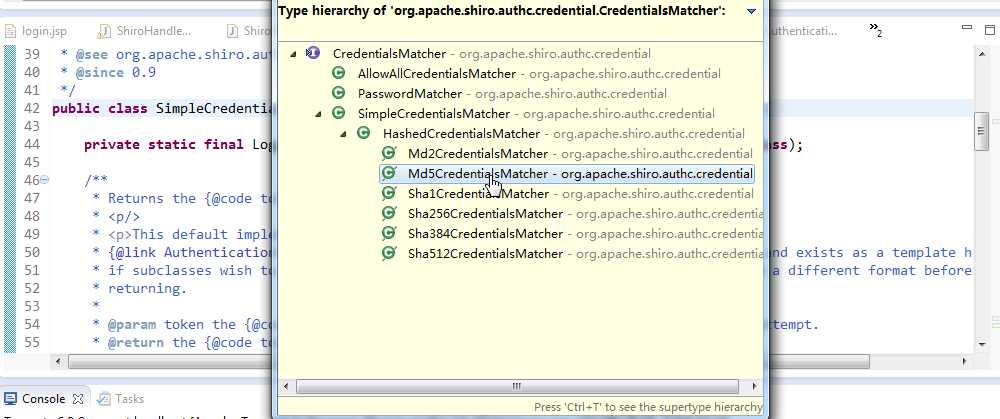标签:ida enabled 按钮 invoke htm mem led remember -o
认证流程:
1. 获取当前的 Subject. 调用 SecurityUtils.getSubject();
2. 测试当前的用户是否已经被认证. 即是否已经登录. 调用 Subject 的 isAuthenticated()
3. 若没有被认证, 则把用户名和密码封装为 UsernamePasswordToken 对象
1). 创建一个表单页面
2). 把请求提交到 SpringMVC 的 Handler
3). 获取用户名和密码.
4. 执行登录: 调用 Subject 的 login(AuthenticationToken) 方法.
5. 自定义 Realm 的方法, 从数据库中获取对应的记录, 返回给 Shiro.
1). 实际上需要继承 org.apache.shiro.realm.AuthenticatingRealm 类
2). 实现 doGetAuthenticationInfo(AuthenticationToken) 方法.
6. 由 shiro 完成对密码的比对.
实现过程:
创建一个login.jsp
<%@ page language="java" contentType="text/html; charset=UTF-8" pageEncoding="UTF-8"%> <!DOCTYPE html PUBLIC "-//W3C//DTD HTML 4.01 Transitional//EN" "http://www.w3.org/TR/html4/loose.dtd"> <html> <head> <meta http-equiv="Content-Type" content="text/html; charset=UTF-8"> <title>Insert title here</title> </head> <body> <h4>Login Page</h4> <form action="shiro/login" method="post"> username: <input type="text" name="userName"/> <br><br> password: <input type="password" name="password" /> <br><br> <input type="submit" value="Submit"/> </form> </body> </html>
登录成功后的list.jsp 包含登出按钮
<%@ page language="java" contentType="text/html; charset=UTF-8"
pageEncoding="UTF-8"%>
<!DOCTYPE html PUBLIC "-//W3C//DTD HTML 4.01 Transitional//EN" "http://www.w3.org/TR/html4/loose.dtd">
<html>
<head>
<meta http-equiv="Content-Type" content="text/html; charset=UTF-8">
<title>Insert title here</title>
</head>
<body>
<h4>List Page</h4>
<a href="shiro/logout">Logout</a>
</body>
</html>
创建一个Controller ShiroHandler.java
package com.java.shiro.realms; import org.apache.shiro.SecurityUtils; import org.apache.shiro.authc.AuthenticationException; import org.apache.shiro.authc.AuthenticationToken; import org.apache.shiro.authc.UsernamePasswordToken; import org.apache.shiro.subject.Subject; import org.springframework.stereotype.Controller; import org.springframework.web.bind.annotation.RequestMapping; import org.springframework.web.bind.annotation.RequestParam; @Controller @RequestMapping("/shiro") public class ShiroHandler { @RequestMapping("/login") public String login(@RequestParam("userName") String userName, @RequestParam("password") String password) { Subject currentUser = SecurityUtils.getSubject(); if (!currentUser.isAuthenticated()) { UsernamePasswordToken token = new UsernamePasswordToken(userName, password); token.setRememberMe(true); try { currentUser.login(token); } catch (AuthenticationException e) { System.out.println("登录失败:" + e.getMessage()); } } return "redirect:/list.jsp"; } }
创建一个Realm 重写AuthenticatingRealm 的doGetAuthenticationInfo()
package com.java.shiro.realms; import org.apache.shiro.authc.AuthenticationException; import org.apache.shiro.authc.AuthenticationInfo; import org.apache.shiro.authc.AuthenticationToken; import org.apache.shiro.authc.LockedAccountException; import org.apache.shiro.authc.SimpleAuthenticationInfo; import org.apache.shiro.authc.UnknownAccountException; import org.apache.shiro.authc.UsernamePasswordToken; import org.apache.shiro.realm.AuthenticatingRealm; public class ShiroRealm extends AuthenticatingRealm { @Override protected AuthenticationInfo doGetAuthenticationInfo( AuthenticationToken token) throws AuthenticationException { System.out.println("doGetAuthenticationInfo " + token); // 1. 把AuthenticationToken 转换为UsernamePasswordToken UsernamePasswordToken up = (UsernamePasswordToken) token; // 2. 从UsernamePasswordToken 中来获取username String username = up.getUsername(); // 3. 调用数据库的方法,从数据库中查询username对应的用户记录 System.out.println("从数据库中获取userName :" + username + " 所对应的用户信息."); // 4. 若用户不存在,则可以抛出 UnknownAccoountException 异常 if ("unknown".equals(username)) { throw new UnknownAccountException("用户不存在"); } // 5. 根据用户信息的情况,决定是否需要抛出其他的AuthencationException 异常 假设用户被锁定 if ("monster".equals(username)) { throw new LockedAccountException("用户被锁定"); } // 6. 根据用户的情况,来构建AuthenticationInfo 对象并返回,通常使用的是 // SimpleAuthenticationInfo // 以下信息是从数据库获取的. Object principal = username; // principal 认证的实体信息. // 可以是username,也可以是数据表对应的用户的实体类对象 String credentials = "123456"; // credentials:密码 String realmName = getName(); AuthenticationInfo info = new SimpleAuthenticationInfo(principal, credentials, realmName); return info; } }
在applicationContext.xml 中添加对应的 过滤器
<?xml version="1.0" encoding="UTF-8"?> <beans xmlns="http://www.springframework.org/schema/beans" xmlns:xsi="http://www.w3.org/2001/XMLSchema-instance" xsi:schemaLocation="http://www.springframework.org/schema/beans http://www.springframework.org/schema/beans/spring-beans.xsd"> <!-- 数据源配置,暂时不考虑数据源,做一些静态的数据 --> <!-- Sample RDBMS data source that would exist in any application - not Shiro related. --> <!-- <bean id="dataSource" class="org.springframework.jdbc.datasource.DriverManagerDataSource"> <property name="driverClassName" value="org.hsqldb.jdbcDriver"/> <property name="url" value="jdbc:hsqldb:mem:shiro-spring"/> <property name="username" value="sa"/> </bean> --> <!-- Populates the sample database with sample users and roles. --> <!-- <bean id="bootstrapDataPopulator" class="org.apache.shiro.samples.spring.BootstrapDataPopulator"> <property name="dataSource" ref="dataSource"/> </bean> --> <!-- Simulated business-tier "Manager", not Shiro related, just an example --> <!-- <bean id="sampleManager" class="org.apache.shiro.samples.spring.DefaultSampleManager"/> --> <!-- ========================================================= Shiro Core Components - Not Spring Specific ========================================================= --> <!-- Shiro‘s main business-tier object for web-enabled applications (use DefaultSecurityManager instead when there is no web environment)--> <!-- 1.配置SecurityManager! --> <bean id="securityManager" class="org.apache.shiro.web.mgt.DefaultWebSecurityManager"> <property name="cacheManager" ref="cacheManager"/> <!-- Single realm app. If you have multiple realms, use the ‘realms‘ property instead. --> <!-- 配置session的管理方式 --> <!-- <property name="sessionMode" value="native"/> --> <property name="realm" ref="jdbcRealm"/> </bean> <!-- Let‘s use some enterprise caching support for better performance. You can replace this with any enterprise caching framework implementation that you like (Terracotta+Ehcache, Coherence, GigaSpaces, etc --> <!-- 2.配置CacheManager,实例上可以用企业的缓存产品来提升性能 2.1需要加入ehcache的jar包及配置文件 --> <bean id="cacheManager" class="org.apache.shiro.cache.ehcache.EhCacheManager"> <!-- Set a net.sf.ehcache.CacheManager instance here if you already have one. If not, a new one will be creaed with a default config: <property name="cacheManager" ref="ehCacheManager"/> --> <!-- If you don‘t have a pre-built net.sf.ehcache.CacheManager instance to inject, but you want a specific Ehcache configuration to be used, specify that here. If you don‘t, a default will be used.: --> <property name="cacheManagerConfigFile" value="classpath:ehcache.xml"/> </bean> <!-- Used by the SecurityManager to access security data (users, roles, etc). Many other realm implementations can be used too (PropertiesRealm, LdapRealm, etc. --> <!-- 3.配置Realm 3.1 自己写一个Realm,需要实现Realm接口 --> <bean id="jdbcRealm" class="com.java.shiro.realms.ShiroRealm"></bean> <!-- ========================================================= Shiro Spring-specific integration ========================================================= --> <!-- Post processor that automatically invokes init() and destroy() methods for Spring-configured Shiro objects so you don‘t have to 1) specify an init-method and destroy-method attributes for every bean definition and 2) even know which Shiro objects require these methods to be called. --> <!-- 4.配置 LifecycleBeanPostProcessor,可以自动的调用配置在spring IOC容器中Shiro bean的声明周期方法 --> <bean id="lifecycleBeanPostProcessor" class="org.apache.shiro.spring.LifecycleBeanPostProcessor"/> <!-- Enable Shiro Annotations for Spring-configured beans. Only run after the lifecycleBeanProcessor has run: --> <!-- 5.启用 IOC 容器中使用 shiro 注解,但必须在配置了LifecycleBeanPostProcessor 之后才可以使用。 --> <bean class="org.springframework.aop.framework.autoproxy.DefaultAdvisorAutoProxyCreator" depends-on="lifecycleBeanPostProcessor"/> <bean class="org.apache.shiro.spring.security.interceptor.AuthorizationAttributeSourceAdvisor"> <property name="securityManager" ref="securityManager"/> </bean> <!-- Secure Spring remoting: Ensure any Spring Remoting method invocations can be associated with a Subject for security checks. --> <!-- 远程调用,暂时不需要 --> <!-- <bean id="secureRemoteInvocationExecutor" class="org.apache.shiro.spring.remoting.SecureRemoteInvocationExecutor"> <property name="securityManager" ref="securityManager"/> </bean> --> <!-- Define the Shiro Filter here (as a FactoryBean) instead of directly in web.xml - web.xml uses the DelegatingFilterProxy to access this bean. This allows us to wire things with more control as well utilize nice Spring things such as PropertiesPlaceholderConfigurer and abstract beans or anything else we might need: --> <!-- 6.配置ShiroFilter 6.1 id 必须和web.xml 中配置的 DelegatingFilterProxy 的 <filter-name> 一致 若不一致,则会抛出:NoSuchBeanDefinitionException.因为Shiro会来IOC容器中查找和<filter-name> 名字对应的filter bean. --> <bean id="shiroFilter" class="org.apache.shiro.spring.web.ShiroFilterFactoryBean"> <property name="securityManager" ref="securityManager"/> <property name="loginUrl" value="/login.jsp"/><!-- 登录页面 --> <property name="successUrl" value="/list.jsp"/><!-- 登录成功页面 --> <property name="unauthorizedUrl" value="/unauthorized.jsp"/><!-- 没有权限的页面 --> <!-- The ‘filters‘ property is not necessary since any declared javax.servlet.Filter bean defined will be automatically acquired and available via its beanName in chain definitions, but you can perform overrides or parent/child consolidated configuration here if you like: --> <!-- <property name="filters"> <util:map> <entry key="aName" value-ref="someFilterPojo"/> </util:map> </property> --> <!-- 配置哪些页面需要受保护 以及访问这些页面需要的权限 1). anon(anonymous) 可以被匿名访问,即不需要登录就可以访问 2). authc(authentication) 必须认证之后,即登录后才可以访问 3). URL 权限采取第一次匹配优先的方式,即从开头使用第一个匹配的url模式对应的拦截器链。 4). logout 登出 --> <property name="filterChainDefinitions"> <value> /login.jsp= anon /shiro/login= anon /shiro/logout = logout # everything else requires authentication: /** = authc </value> </property> </bean> </beans>
在登录成功后,点击后退,再次随便输入依旧能够登录成果,是由于缓存的作用。
密码的比对:
通过AuthenticatingRealm 的 credentialsMatcher 属性进行的比对

credentialsMatcher 非常重要,因为在生产中数据库存的密码不会是一个明文的密码,会是一个加密后的密码,比对加密的密码也是通过credentialsMatcher 来进行比对

标签:ida enabled 按钮 invoke htm mem led remember -o
原文地址:http://www.cnblogs.com/wq3435/p/6260483.html